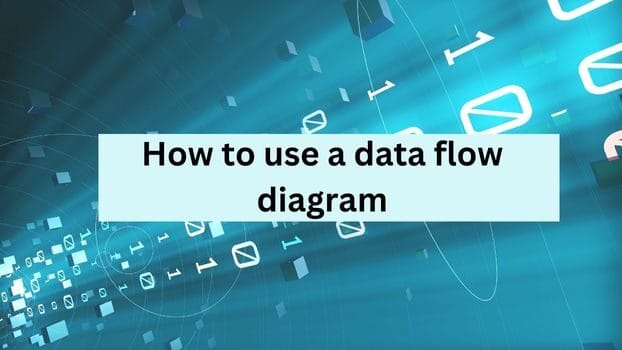The best way to enhance anything — whether that’s running a business or running a coffee shop — is to figure out step-by-step what’s working while allowing go of what is not.
When it arrives at a cup of coffee, it’s a fairly easy method. But when you’re handling a business or unit, things get more complicated. With a million projects, tasks, as well as operations running simultaneously, determining which parts are working and phasing out those that aren’t is decidedly more complex. This is where we data flow diagram is used and comes in.
What is a data flow diagram?
Flow charts are used to visualize a process as a series of steps by breaking down the key points and what they entail. They help map out various phases of work and illustrate the route, or flow, in which everything is moving. They can detail information about all aspects of this process, from input to output and even the crucial stages in between. There are a lot of ways for us to end up depressed and disheartened in this world.
We have so many responsibilities that the suffering doesn’t fade away. But we have no other option but to deal with them by ourselves or live with them until we die which is not exactly something worth looking forward to.
I hope you can invest time in reading articles and watching videos on how you can reduce stress levels, build confidence and transform yourself into someone who might just turn out to be much happier than you’re used to feeling all day every day.
Simply put, Data Flow Diagrams (DFDs) are a visual representation of a process or system, simply depicted as nodes and lines that connect them. You can use DFDs to show the various interactions between different parts of the whole, which in turn provides a quick and efficient means of working out where there might be inefficiencies in your processes or system.
We can also discuss about Data Flow Diagram of Insurance Management System. You can learn this article by clicking here.
Types of DFDs
There are two types of data flow diagrams to select from hanging on what you want to look at in your flow diagram.
Logical DFDs
Logical data flow charts are beneficial because they help you to understand what’s happening to your data through the information flow, who it’s being shared with, and where that data goes. Business activities are the processes that are used to execute the functions of a business, and they should be easy for a non-technical audience to follow. Logical DFDs help you to understand these processes visually without having to do any mental computations or interpretations.
Here are some points of logical DFDs:-
Longevity and relevance:
a tool that constantly updates its processes will be different from one that doesn’t constantly update. If a tool is already up-to-date, there’s usually no reason to update your diagram again.
Clear implementation plans:
The diagram above provides a visual representation of the students’ learning experience and visually highlights where they can get help.
Straightforward:
Because they are simplified as well as less complex, logical DFDs are great for communicating your goals with peers, mentors, as well as VCs.
Multifunctional:
a logical data flow diagram gives an overview of how the data transfers through the application as well as enhances the speed at which users can imagine what’s going on.
Physical DFDs
Data flow diagrams (DFDs) present you with a visual presentation of your product or project’s data flow. Your physical DFD may vary depending on what your project entails, but the general principle of its structures is relatively straightforward in that they show how information moves through your business. For example, an e-commerce diagram could show you how a customer places an order online and how the data flows from one department to another throughout the process.
Here are some points of Physical DFDs:-
Details:
Every step of a process is included to fine-tune the system and enhance efficiency, as well as address potential hurdles head-on.
Clarity:
The second and final way to build a physical data flow diagram is by using real names when describing the data involved. Since many of those real names will be the same as the ones in your logical DFD.
Differentiation:
Instructing diagram that separates activities and processes based on a combination of seemingly complex. But fundamental factors, such as the role(s) played during an activity, the tool used. The amount of accuracy required for less acceptable tasks.
You can make both diagrams to represent the same knowledge flow, but each would tell another side of the story as well as supply different actions to be optimized. Use logical as well as physical DFDs individually or in meeting for more powerful visualization.

Data Flow Diagram Symbols
In this article, we discuss two primary methods of notation used in DFDs: First is Gane & Sarson vs. second is Yourdon & coad. They vary little, but both use shapes as well as symbols to describe the four main elements of a DFD:
- External Entity
- Process
- Data Store
- Data Flow
External Entity
An external system that’s either a data source or goal. You’ll usually find them near the borders of a DFD.
Process
something that involves the data and its flow by adjusting it, sorting it, or controlling its flow of movement. Processes sit between the input as well as the output, and a single diagram can contain several of them.
Datastore
data stores have data after use. Inputs can flow through a process as well as into a data store. Then back out of the data store and via a method.
Data flow
data flow keeps your data way through the different methods as well as data stores.
How to create Data Flow Diagram?
- The diagram Sort your ingredients from your hosts. Each process should have an ingredient and a host. Remember this, and you won’t end up with any flexible backs.
- Begin at Level 0 by making an easy system context diagram with one single operation.
- Now it’s time to add more information to your diagram. Remember, though, process diagrams are different than other types of diagrams in that you need to start with low-level items as well as slowly build on top of them.
Applications of Data Flow Diagram
DFDs are useful in processes that include many levels of decision-making in-between stages of ideation as well as structure. They also benefit industries that rely on frequent data sharing as well as processing in everyday activities. The next applications are just a few samples of how as well as when to utilize data flow diagrams.
Software Engineering
Data flow diagrams were first created by engineers in this industry and are still used widely as a design tool when coding software programs. However, they’re also used extensively during the testing phase to measure the performance of existing systems and assess how well connected everything is.
Any potential sources of error can be detected close to the beginning of development . It looked at closely while they’re still relatively small so that fixes can be made quickly.
Business Process Management
Whether you want to improve or streamline operations, DFDs or data flow diagrams are incredible tools for analyzing workflows. This can range from streamlining specific operations related to logistics, and resources. Improving an organizational change in process as mentioned above.
Database Development
Organizations that depend heavily on complex databases such as healthcare facilities and government agencies can use DFDs to protect the integrity of their data.
Healthcare, as well as government organizations, are known for transmitting data at many additional levels. They’re subject to conditions for how and where that data is stored.
Data flow diagrams help these companies plot out complex data series as well as keep how agents. It providers have access to data at each step.
Conclusion
The Organization is vital in understanding the current state of your project in terms of its technical architecture. Because data flow diagrams are organized representations of systems. It is important to have a solid plan for your documentation from the start.
It’s not uncommon to see people use a myriad of tools to create their DFDs. It still expect a cohesive whole when the time comes for implementation. A good solution is using templates for each element such as Data Flow Diagram Templates. These types of resources simplify each piece without sacrificing readability or compatibility with other structures and processes you may have.






